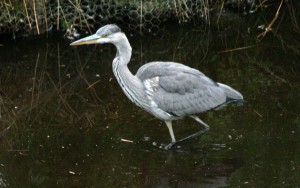 The panoramic view from the RSPB Hide at Udale Bay near Cromarty seemed to have, last week, so many birds it was difficult to choose which ones to look at. The tide was well out but even so most of the birds were still packed onto the small area of marsh almost in front of the hide and its admirable viewpoints. Unusually they were dominated by large numbers of Canada geese that were well scattered over the marsh and intent on grazing. I have never seen so many of these attractive geese at Udale although records show that they sometimes build up to around 150 in August in some years. They looked as though they were hungry and they posed a mystery as to where they came from. The point is that very few actually breed in the Highlands and the latest “Highland Bird Report” lists them breeding and increasing in Lochaber, the only regular site in the Highlands, and as a summer moulting migrant to the Moray Firth. So it looks as though the hungry Canada geese have flown up from England to moult in Udale Bay and other firths.
The panoramic view from the RSPB Hide at Udale Bay near Cromarty seemed to have, last week, so many birds it was difficult to choose which ones to look at. The tide was well out but even so most of the birds were still packed onto the small area of marsh almost in front of the hide and its admirable viewpoints. Unusually they were dominated by large numbers of Canada geese that were well scattered over the marsh and intent on grazing. I have never seen so many of these attractive geese at Udale although records show that they sometimes build up to around 150 in August in some years. They looked as though they were hungry and they posed a mystery as to where they came from. The point is that very few actually breed in the Highlands and the latest “Highland Bird Report” lists them breeding and increasing in Lochaber, the only regular site in the Highlands, and as a summer moulting migrant to the Moray Firth. So it looks as though the hungry Canada geese have flown up from England to moult in Udale Bay and other firths.
Of all the birds to see at Udale Bay at any time of the year and one of my favourites is the heron which many people just ignore. You can always see herons in the bay although never in large numbers. If you are lucky, as I was last week, one will be fishing in the shallows of the water course just in front of the hide, hence the photograph. It was the typical pose of a heron, slow and deliberate as though it was one of the giants from Wagner’s “Ring Cycle”. Then suddenly that dagger like, huge beak will move and impale a fish. There were a few other herons scattered over the marsh with most of them in their typical pose of the long neck sunk into the shoulders and just sitting motionless as though they were asleep. Just occasionally one would move and then the sheer size of the huge wings would be apparent as they slowly flew along although their speed is often deceptive. There are several heronries in the Highlands and one of the largest is just on the western edge of Inverness where there are often up to 40 nests. Some of these birds wander inland at this time of the year and fish in lochs and rivers, even burns. But at the slightest sign of cold weather they will move to the coasts to join others that probably live there all the year round.
There were other fishermen at Udale Bay but I had to go to the nearby Newhall Point to see them. There, just off the shore, were up to 20 arctic terns and they were fishing in shallow water the whole time I was watching them. Occasionally a juvenile would land on a rock and wait to be fed by the adults. Well might these terns be called sea swallows as they do resemble larger than life swallows. Their headlong dive after fish in the shallows is spectacular as if in sheer abandon. Their quarry is very small fish and there are around 47,000 pairs in Scotland which is an astonishing 80% of the UK population. These birds are quite remarkable as they have one of the longest migration flights of any birds in the world. They migrate south to spend the winter fishing at the other end of the world in the Southern ocean off the pack ice of Antarctica and some British birds reach Australia. How remarkable for such a small bird fishing in late summer at Udale Bay!!
